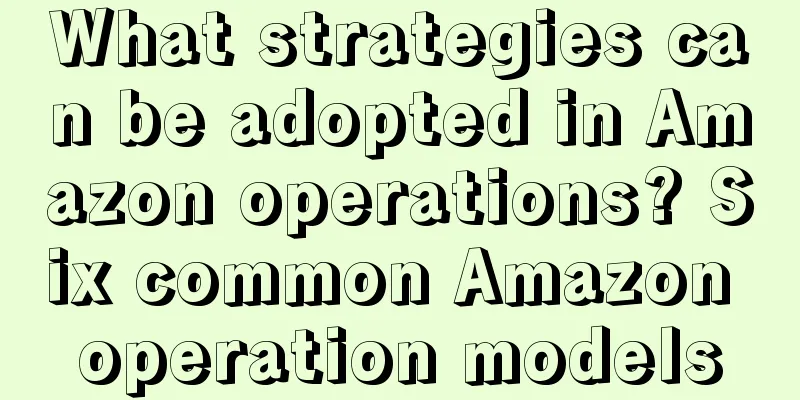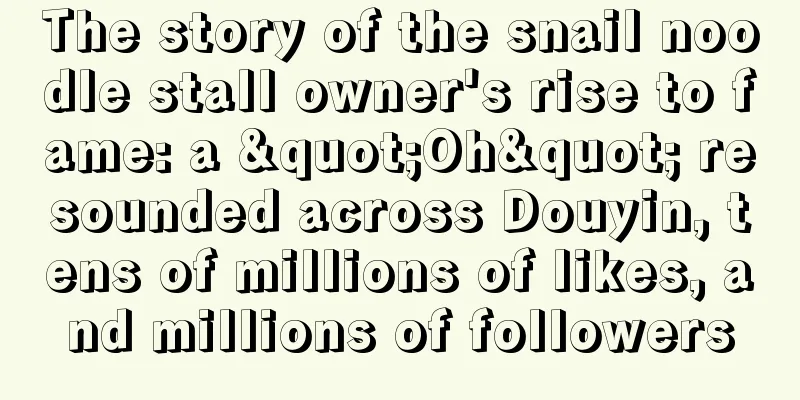The return rate of jewelry live streaming is 90%? Live streaming brings goods, impulse buying, so the return rate is of course high

Some time ago, some people complained about the live streaming sales in the jewelry industry during the 618 shopping festival. They invested a lot of manpower and logistics to achieve good sales, but the return rate of the goods sold exceeded 90%. Before livestreaming, although there were many returns on e-commerce platforms, a 90% return rate was a bit scary. Although livestreaming is an innovation in e-commerce and has been extremely popular in recent years, its return rate has indeed always been high. 1. The high return rate of live streaming salesThe high return rate is common knowledge in the live streaming e-commerce industry, but basically no large organization or media will independently collect data related to this aspect. After all, this is not data that can be brought to the table and talked about. We can only get an approximate value of this data from some scattered reports. The 2020 China Live E-commerce Industry Research Report pointed out that the average return rate of live e-commerce is 30%-50%, which is higher than the 10%-15% return rate of traditional e-commerce. A related survey showed that the return rate of live e-commerce reached 30%, and only 27.01% of users said that "very few returns and cancel orders." I once talked with an MCN manager about live streaming sales. In one case he provided, a live streamer sold 10 million yuan worth of goods at one time, but ended up returning 6.5 million yuan, a return rate of 65%. At the time, I thought this data was outrageous, but compared with the 90% return rate of jewelry at the beginning, it can even be considered normal. The high return rate has always been a chronic problem in the live streaming e-commerce industry. The reason why it is much higher than the return rate of online business and shelf e-commerce is due to the characteristics of live streaming e-commerce. 2. The fundamental reason for the high return rate of live streaming salesThe human decision-making model is the ELM model proposed by American psychologist Richard Petty and his partner John Cacioppo. The ELM model believes that there are two models for human persuasion, namely the central path and the peripheral path. In the central path, people will make decisions after rational thinking and careful consideration; while in the peripheral path, people are usually unwilling to spend too much energy to analyze the problem and are more easily persuaded by superficial factors. In the central path decision-making model, people's thinking is like spreading along a central axis, with clear logic and clear cause and effect. In the peripheral path model, people's thinking is boundless and easily distracted and disturbed by various peripheral factors. For example, when you buy a mobile phone, you use the central path when you make a decision based on the phone's configuration, functions and price; and when you make a decision based on the phone's spokesperson and color, you use the peripheral path. Israeli Daniel Kahneman later proposed two systems of human thinking in "Thinking, Fast and Slow". System 1 operates unconsciously and quickly, does not require much brainpower, has no feelings, and is completely under autonomous control, which can be called fast thinking. System 2 shifts attention to brain activities that require brainpower, such as complex calculations, which can be called slow thinking. Here, slow thinking corresponds to the central path in the ELM model, and fast thinking corresponds to the peripheral path. People make many decisions every day, and most of these decisions use fast thinking. In advertising and marketing, we are deeply influenced by quick thinking. We are always influenced by emotional factors such as appearance, color, spokesperson, etc. in marketing, thus making less rational consumption decisions. It is for this reason that most brands in the marketing field today pay more attention to emotional marketing. Although the peripheral path or fast thinking is more likely to promote consumers' purchasing behavior in the short term by stimulating their emotional thinking, it also has its flaws. Compared with the central path, the change in consumer attitudes caused by the peripheral path is often short-lived. After all, consumers do not make decisions after careful consideration. For example, when they find that the product they bought on impulse is not what they really want, they will regret it. It is for this reason that "returns" always become a hot topic on the second day after the big promotion ends. When consumers use the peripheral route to make decisions, they will always have too high expectations for the product due to the influence of certain emotional factors. When the product is received, they often find that the product is far below their expectations, which leads to disappointment with the brand. 3. Livestreaming is a peripheral channel, impulsive consumptionThe peripheral path or fast thinking in the consumer field refers to impulse consumption, and the characteristics of live streaming sales are in line with the peripheral path of decision-making. The following characteristics of live streaming sales are fully reflected. 1. Live commentary is more exaggerated than fixed advertising materialsThe most important feature of live streaming sales is of course its intuitiveness. Compared with the pictures and texts on shelf e-commerce, the on-site commentary naturally contains elements of performance, art, and exaggeration. Exaggerating some product functions and effects in an artistic form during the commentary will arouse consumers' emotional thinking and thus promote their quick purchase. An exaggerated example is that a man in Dezhou, Shandong, bought five buckets of instant noodles online for 9.9 yuan. After receiving the goods, he found that the five buckets of instant noodles were only the size of a thumb. 2. The anchor makes people love the host and love the dogIn the era of traditional media, many products use celebrities to advertise, which can often quickly increase their popularity and promote sales. When a consumer likes a celebrity, he or she will often buy the product endorsed by the celebrity. From a psychological perspective, celebrities use the emotional transfer effect when advertising products. Emotional transfer refers to people transferring their emotions towards a certain person or thing to another person or thing related to it. In live streaming, many people quickly make purchases purely out of their love and trust for the anchor, and such purchases are often irrational. 3. Use low prices to stimulate quick thinkingAn important factor that stimulates consumers' quick thinking is price. When the price of a product is lower than the consumer's psychological expectations, there will be more purchasing behavior. In live streaming, the anchor will first give a very high original price, and then give a very low discounted price. The usual rhetoric is: This product originally costs 298 yuan, but in my live streaming room it only costs 98 yuan. If you buy it today, you will also get XX worth 99 yuan. XX originally costs 299 yuan. If you place an order today, you will get it immediately. What are you waiting for... " Here, consumers will use the original price as a reference point and think that the discounted price is much cheaper than the original price. Coupled with the host's strong sense of urgency in explaining, consumers feel that they will lose out if they don't buy it now, so quick thinking comes into play and they make a quick purchase decision. 4. Use gifts to stimulate quick thinkingWhen a consumer buys a product worth 100 yuan, and the anchor gives him a gift worth 20 yuan, the consumer will not feel that he has saved 20 yuan by buying the product, but will feel that he has earned an extra 20 yuan . Note that these two methods are completely different. When there is a gift, the consumer's psychological activity is: I need to buy something anyway, and I can earn 20 yuan by buying this thing, so why don't I buy it? The gifts in the live broadcast room play a very important role in sales promotion. Sometimes, when buying a product, the gifts given by the anchor during the introduction are much higher than the above case, which makes people feel that they have taken a great bargain. Everyone likes to take advantage of others. Taking advantage of others when consuming stimulates people's quick thinking, thus promoting people's impulse consumption. But in fact, the gifts seem to be a lot, but in fact the value is very low. Many people who consume for gifts regret it after receiving the goods. Live streaming sales stimulates people’s peripheral paths or quick thinking in consumption decisions through various means, causing them to make impulse purchases. Of course, short videos also have this problem. Compared with pictures and texts, short videos have a higher artistic content. The so-called grass-planting short videos are inevitably exaggerated and also stimulate people's impulse consumption. The consequence of impulse consumption is regret. IV. The drawbacks of excessive use of peripheral marketing channelsMarketing using peripheral paths or fast thinking can certainly promote people's consumption, but in fact, most mature brands use both fast and slow thinking in their marketing. They use slow thinking to cultivate consumers' awareness and loyalty to the brand, and use fast thinking to promote the final sales. If you use quick thinking alone for marketing, it will cause many problems. 1. Reduce brand valueIt is not a good thing for well-known brands to participate in live broadcasting too much. The products supplied by well-known brands in the live broadcast room must be low-priced, so they are often leftovers, and many gifts are also given. Audiences who often buy in the live broadcast room will think that these brands are originally priced at this price, and thus correspond their prices to brand value, lowering their own evaluation of brand value. In this case, consumers will never consider buying branded goods at full price. In the long run, the value of the brand will inevitably decrease. 2. Reduce brand trustBecause live streaming with fast thinking promotes impulse buying, many consumers have very high expectations for products and think they are worth the money, but when they get the products, they find that they are not as worth the money as they imagined. At this time, their slow thinking starts to work, and they think the brand is fooling them, so they decisively choose to return the products. A return may not be fatal, but it affects the brand's image in the minds of consumers. Consumers no longer trust the brand, and the result of this in the long run is that consumers are disappointed with the brand and no longer repurchase. V. ConclusionUsing peripheral paths or fast thinking marketing is the most important means of marketing today. But as mentioned above, the marketing of mature brands combines both fast and slow thinking. They cultivate consumers' awareness and loyalty to the brand through slow thinking, and promote the final sales through fast thinking. Live streaming sales is essentially pure quick-thinking marketing, which promotes impulse purchases and will have long-term negative impacts on the brand. It’s not that live streaming sales are not possible. Brands should evaluate the frequency and methods of live streaming sales so that this marketing method can enhance rather than reduce the brand’s value. Author: Xunkong, WeChat public account: "Xunkong's Marketing Revelation" |
<<: Tea and coffee shops are eyeing young people’s breakfast
>>: Do data analysis like this and operations quarrels will be reduced by half
Recommend
How to add a carousel to an independent website? What are the requirements for a carousel?
Adding a carousel to an independent website is a c...
What is LTV analysis?
What is LTV analysis? How to calculate it? How to ...
How to join shein? What are the conditions for joining?
As a world-renowned online retailer, Shein's u...
Big anchors are losing the low-price machete|Juchao
Big anchors used to use the "lowest price on ...
Xiaohongshu pyramid operation model: from traffic to strategy, from short-term to long-term value
How to create a hit article on Xiaohongshu? Is the...
Can individual business owners open Amazon stores? How to operate Amazon?
No matter which platform you open a store on, you ...
What is the appropriate advertising rate on eBay? What are the fees eBay charges?
eBay is a relatively fast-growing cross-border e-c...
Brand No. 1: 5 rules of business war between the second and the first
In the fast-paced life, new brands emerge in endle...
Retweet + Like + Like 100,000+, the traffic code of the popular video account
This official promotional video titled "Ridin...
What is the transaction process for cross-border e-commerce sellers? What should you pay attention to?
Now many people want to start their own business. ...
Amazon will update the logistics process of creating shipments
Amazon Global Selling announced that the "Sen...
Want to be an IP? Copy Duolingo's homework
This article mainly introduces how Duolingo, throu...
eBay expands the scope of its e-return service
In June this year, eBay launched the eBay Free Ret...
In this Olympic marketing, who is more cunning, Yili or Mengniu?
On the marketing stage of the Paris Olympics, the ...
Is Shopee Vietnam easy to operate? Detailed analysis
Many people want to join Shopee because the platfo...









